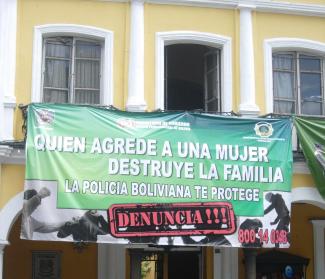Gender
Violence results from patriarchal attitudes
 Mysorekar
Mysorekar
What is the situation in Bolivia in regard to gender-based violence?
In a comparative study done in 12 Latin American countries by the Organización Panamericana de la Salud (OPS) in 2013, Bolivia came first in physical and sexualised violence against women, perpetrated by their partner or ex-partner, with 53 % of all Bolivian women being affected. Colombia and Peru are in the second place, with 40 % of women affected. According to Bolivia’s Vice-Ministry of Equal Opportunities (VIO), nine out of 10 women in Bolivia fall victim of some kind of violence, and 87 % of them suffer that violence in the family. Every three days, a woman is murdered, according to the Centro de Investigación y Desarrollo de la Mujer (CIDEM).
I’ve been told there is a wave of women being killed in Bolivia – is that so?
Yes, it is. Human-rights organisations and the feminist movement have called attention to the femicides. According to CIDEM data, from January to October of 2014, 103 femicides were registered in the country, which was more than in 2013. More than 60 % of the victims were murdered by their own partners, which the perpetrators explained with “jealousy”. A third of the women were killed by beatings.
What are the underlying reasons for violence?
The dramatic situation in Bolivia results from a society that considers women the property of men. The judicial system does not grant justice to the victims, and often lets the aggressors go free. Many women, moreover, are not aware of their rights, and there is a lack of clear political measures to promote respect and equality between men and women. Basically, the reasons are the same as anywhere in the world – structurally unequal power relations between men and women, the patriarchal system. Some say that this is a colonial legacy, and pre-colonial indigenous societies had equal relations between men and women, but various indicators show that pre-colonial societies were also organised along patriarchal structures. Bolivian machismo is also part of the indigenous cultures.
Are there differences between urban and rural regions?
While violence against women is found everywhere, it is more pronounced in the rural areas. Indigenous women represent 20.8 % of the Bolivian people, and they face double discrimination, as women and as indigenous people. In the health sector, the differences are evident. Bolivia has one of the highest maternal death rates, it goes up to 190 deaths per 100,000 live births, according to the OPS. The probability for a rural woman to die due to pregnancy or childbirth is four times higher than for a woman from an urban area. Women in the countryside often have no access to hospitals, because they are too far away or too expensive, or they don’t go because they face discrimination for cultural reasons. For instance, indigenous women traditionally give birth squatting upright, but in hospitals, they are supposed to give birth lying down. Lately, the state has addressed this issue by opening intercultural community health centres called Salud Familiar Comunitaria Intercultural (SAFCI).
Is violence against girls who are not yet adults a particular problem?
Girls and teenagers are particularly prone to be confronted with sexualised violence. According to figures from the ombudsman, 34 % of girls suffer sexual abuses before they are 18 years of age, mostly at the hand of family members, teachers or neighbours. Many cases of rape end with the death of the teenager. In 2014, minors made up 13.6 % of all femicides. The number of teenage pregnancies is also growing. Teenage pregnancies are the major obstacle for girls for completing their education. As young mothers, being financially dependent on their parents or partner, makes them more vulnerable to violent abuse.
What do people say to justify gender-based violence?
Generally, alcohol is given as an explanation, although drink is only the trigger, not the reason for violence. In cases of sexualised violence, victims are often blamed, for wearing “provocative” clothes or having “given consent”.
Where is violence against women mostly perpetrated – at home or at work?
It happens everywhere, but above all where a woman should be safe – at home. Violence at the work place is also common. Women often have precarious jobs in the informal sector and are less paid than men, and men take advantage of them. However, there is also a political dimension. The idea is to stop women from occupying public positions. They are physically and verbally attacked, threatened or kidnapped. Only 4.7 % of cases of political violence against women are ever brought to court.
How does the Bolivian police react when a woman comes to file a complaint against her partner because of violence?
Policemen are like any other men; they tend to play down gender-based violence. For instance, if a woman is not visibly injured, they often tell her not to file a complaint. However, there is the political will to change things. A special force within the Bolivian police has been formed, called “Fuerza Especial de Lucha Contra la Violencia (FELCV)”. Its job is to prevent, investigate and combat violence against women and girls. Capacity building for investigators regarding gender issues is under way. And the law 348 has been designed to guarantee women a life free of violence. That was an important reform. It was passed in 2013 and made a state priority.
Has it made a difference at the grass-roots level?
Well, as soon as a woman or her family take a matter of violence to court, lots of obstacles arise. For instance, victims are often persuaded to agree to a reconciliation, even though law 348 only allows such reconciliations in very special cases. Nonetheless, a lot of exceptions are made. Law 348 also states that victims must get protection immediately, but it often takes weeks or even months for that to happen, so the women continue to be at risk. And although law 348 makes it mandatory for every case of violence to be investigated, whether a complaint is filed or not, state prosecutors hardly do anything unless the victim hires a lawyer. Many women cannot afford one, however, so they continue to live with their aggressor.
Is the judiciary responding appropriately, for instance, to the femicides you mentioned?No, unfortunately not. Justice is too slow. Only in eight of the 206 femicides between January 2013 and November 2014 did courts issue a sentence, according to CIDEM. The good news, however, is that law school curriculum now includes law 348 and awareness raising for gender issues. Prosecutors are being trained in these issues too.
What does the government do to improve the situation?
It is very positive that, in the past 20 years, Bolivia has signed all important international agreements on eliminating violence against women. At the national level, the new constitution of 2009 refers to gender equality in more than 30 articles. Moreover, there are laws concerning equal opportunities, especially for indigenous women. And as I’ve already said, law 348 was an important reform.
What is necessary to eliminate violence against women?
- First of all, we need preventive action. Laws in themselves are not enough. Education programmes for teenagers regarding gender equality and mutual respect are important.
- Secondly, the justice system needs to become a credible institution for citizens in general and women in particular. Impunity must stop; crimes against women need to be punished.
- Finally, the Vice-Ministry of Equal Opportunities should become a proper ministry with the necessary funding.
Are civil-society organisations working on these issues?
Yes, they are. Especially indigenous women are active, for instance, the Confederación Nacional de Mujeres Campesinas Indígenas Originarias de Bolivia “Bartolina Sisa”. The confederation is named after an 18th century female leader of the Aymara people. She fought the Spanish colonisers. Many indigenous women’s organisations today are fighting for a number of causes, including the protection of the forests and their right to indigenous territories.
Internationally, what can be done to support the fight against gender-based violence in Bolivia?
In the context of development programmes, the efforts to reach gender equality and women’s empowerment need to be stepped up. Working for gender equality is not only a goal in itself, but also a precondition for sustainable development which includes everybody. As a tangible example, the German GIZ is cooperating with local governments in its regional programme Combatir la Violencia contra las Mujeres en Latinoamérica (COMVOMUJER - Fighting Violence against Women in Latin America).
Rosse Mary Camacho Justiniano is a consultant with the GIZ Bolivia. She specialises in gender issues and communication.
rossecamacho@hotmail.com

